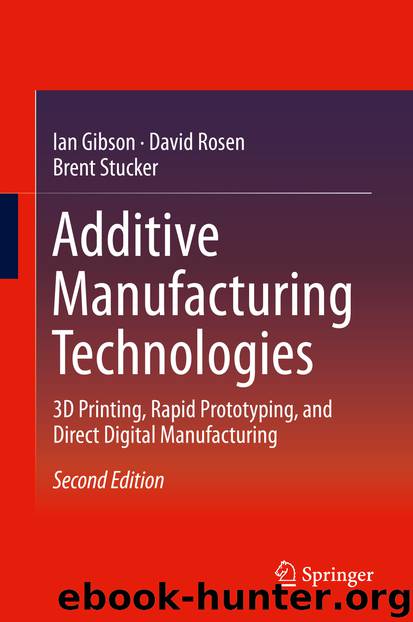Additive Manufacturing Technologies by Ian Gibson David Rosen & Brent Stucker

Author:Ian Gibson, David Rosen & Brent Stucker
Language: eng
Format: epub
Publisher: Springer New York, New York, NY
Defects strongly affect the strength of UAM parts. Process parameter optimization (including optimization of width settings) to maximize LWD and minimize Type-3 defects is the most effective means to increase bond strength. With optimized parameters, Type-1 and Type-3 defects are minimized and Type-2 defects do not occur.
Type-1 defects can be reduced by surface machining a small amount of metal (~10 μm, or the largest roughness observed at the upper-most deposited surface, as in Fig. 9.9) after depositing each layer. Post-process heat treatment can also be used to significantly reduce all types of defects.
The degradation of part mechanical properties due to Type-3 defects can be reduced by designed arrangement of successive layers. Successive layers in a UAM part can be arranged so that 50 % overlap across layers is obtained, as shown in Fig. 9.13. Although somewhat counter-intuitive, it has been shown that better tensile properties result from a 50 % overlap than when random foil arrangements are used.
Fig. 9.13Schematic illustrating (a) 50 % foil overlap and (b) random foil overlap in UAM
Download
This site does not store any files on its server. We only index and link to content provided by other sites. Please contact the content providers to delete copyright contents if any and email us, we'll remove relevant links or contents immediately.
Whiskies Galore by Ian Buxton(41941)
Introduction to Aircraft Design (Cambridge Aerospace Series) by John P. Fielding(33095)
Small Unmanned Fixed-wing Aircraft Design by Andrew J. Keane Andras Sobester James P. Scanlan & András Sóbester & James P. Scanlan(32766)
Craft Beer for the Homebrewer by Michael Agnew(18199)
Turbulence by E. J. Noyes(7983)
The Complete Stick Figure Physics Tutorials by Allen Sarah(7339)
Kaplan MCAT General Chemistry Review by Kaplan(6903)
The Thirst by Nesbo Jo(6882)
Bad Blood by John Carreyrou(6584)
Modelling of Convective Heat and Mass Transfer in Rotating Flows by Igor V. Shevchuk(6408)
Learning SQL by Alan Beaulieu(6239)
Weapons of Math Destruction by Cathy O'Neil(6220)
Man-made Catastrophes and Risk Information Concealment by Dmitry Chernov & Didier Sornette(5958)
Digital Minimalism by Cal Newport;(5707)
Life 3.0: Being Human in the Age of Artificial Intelligence by Tegmark Max(5518)
iGen by Jean M. Twenge(5387)
Secrets of Antigravity Propulsion: Tesla, UFOs, and Classified Aerospace Technology by Ph.D. Paul A. Laviolette(5336)
Design of Trajectory Optimization Approach for Space Maneuver Vehicle Skip Entry Problems by Runqi Chai & Al Savvaris & Antonios Tsourdos & Senchun Chai(5039)
Pale Blue Dot by Carl Sagan(4960)
